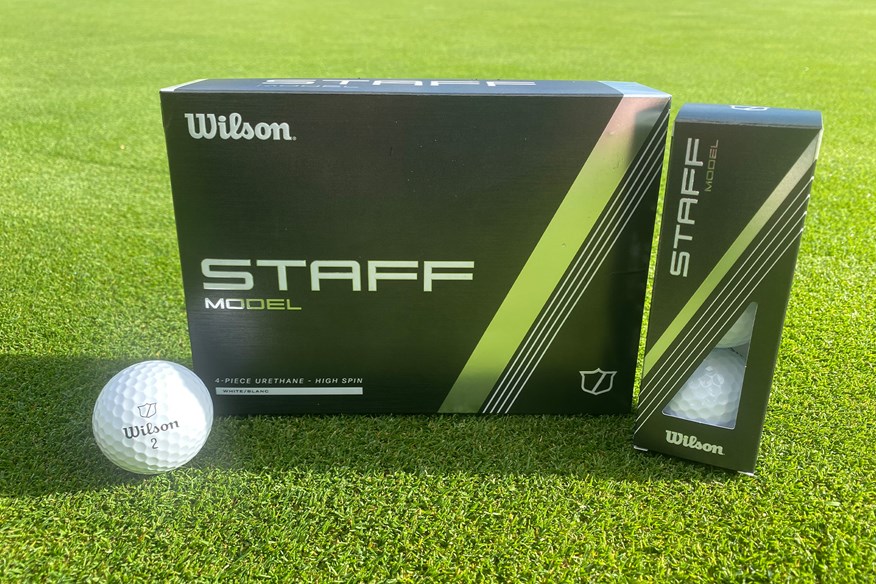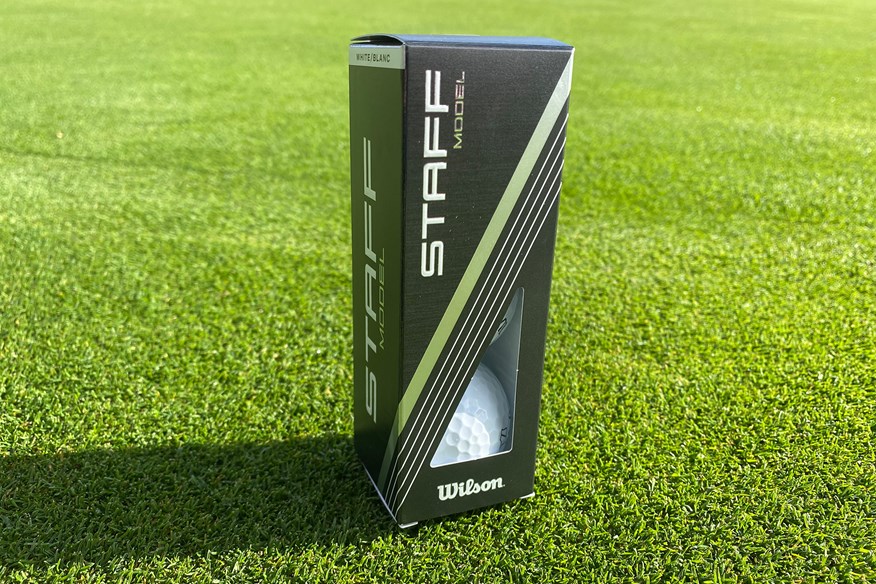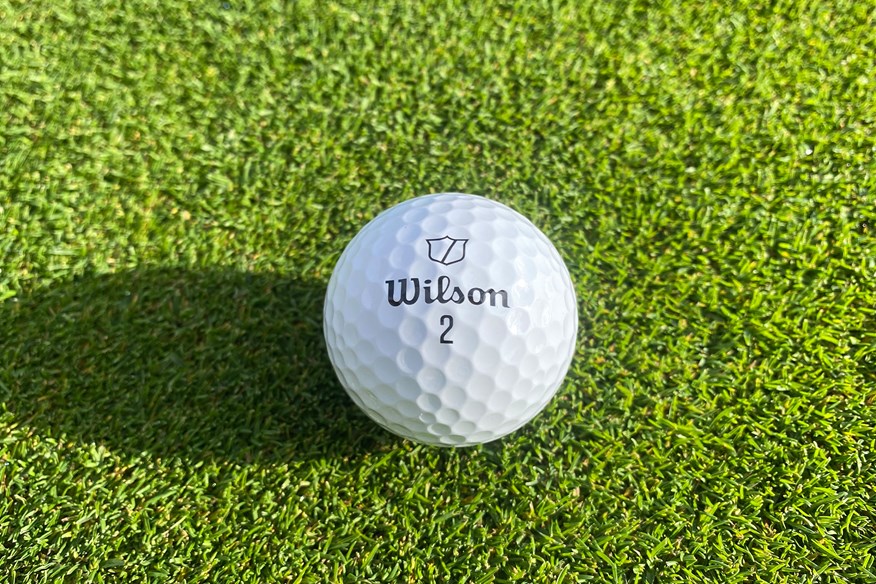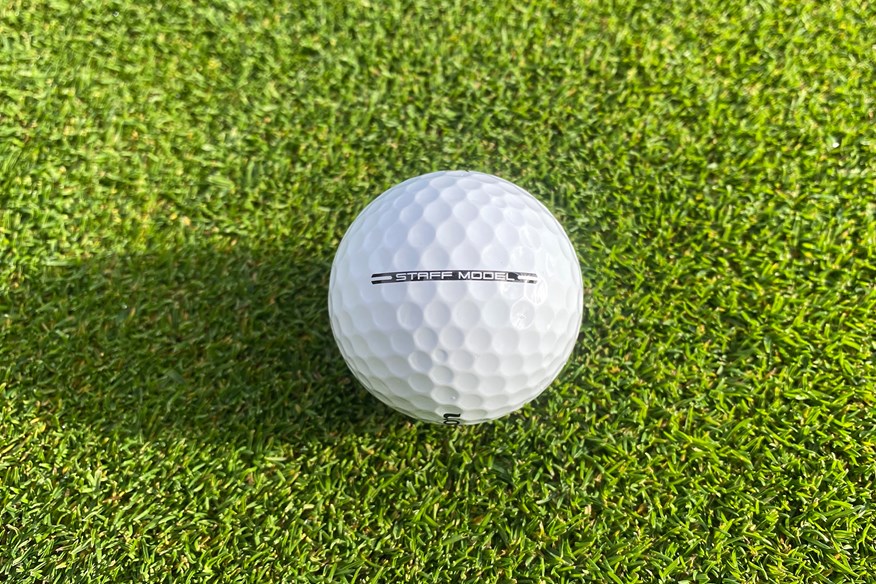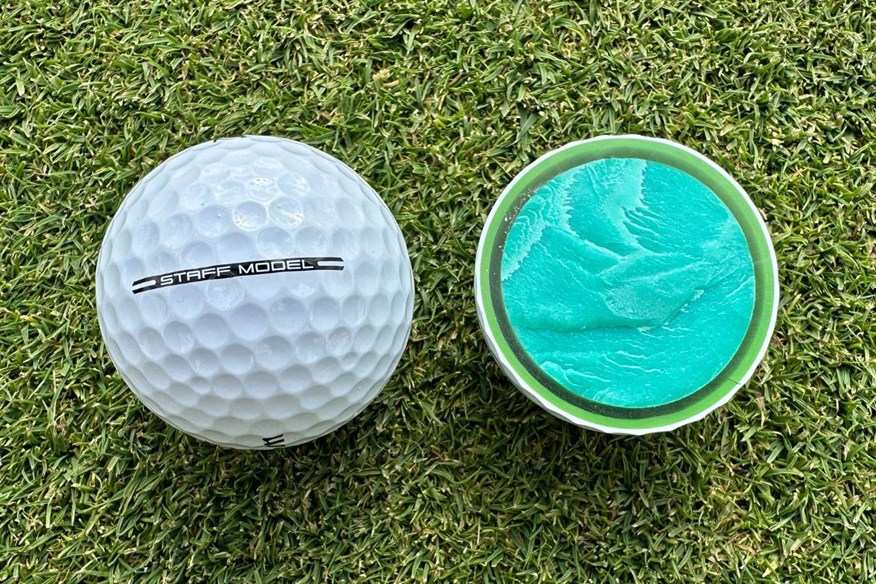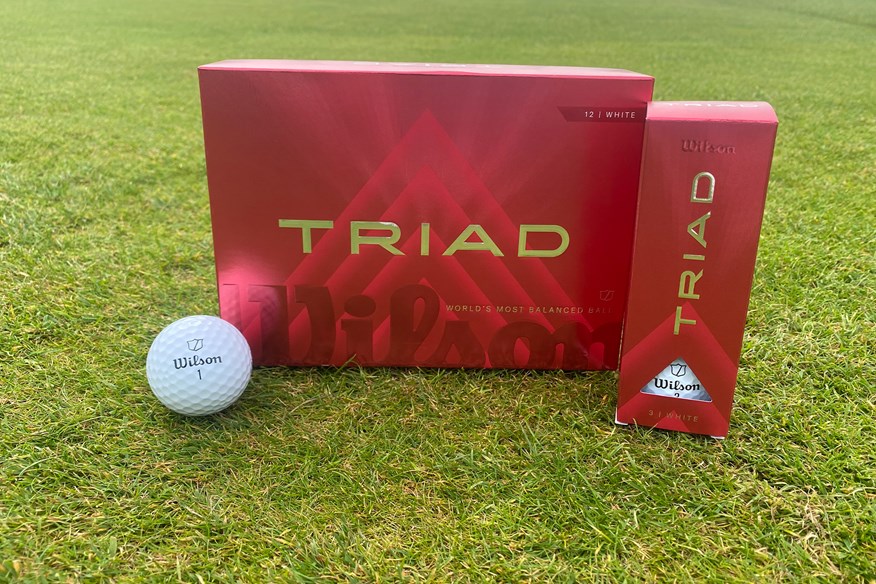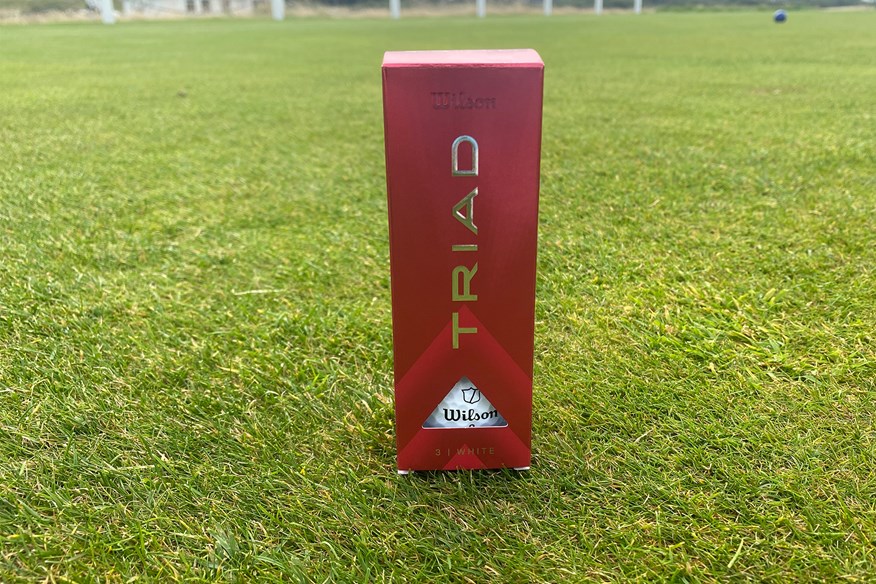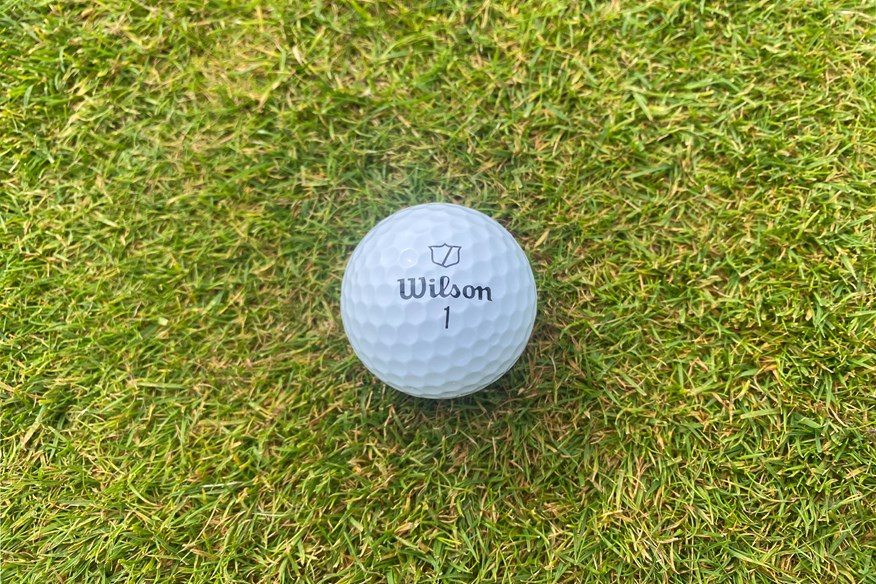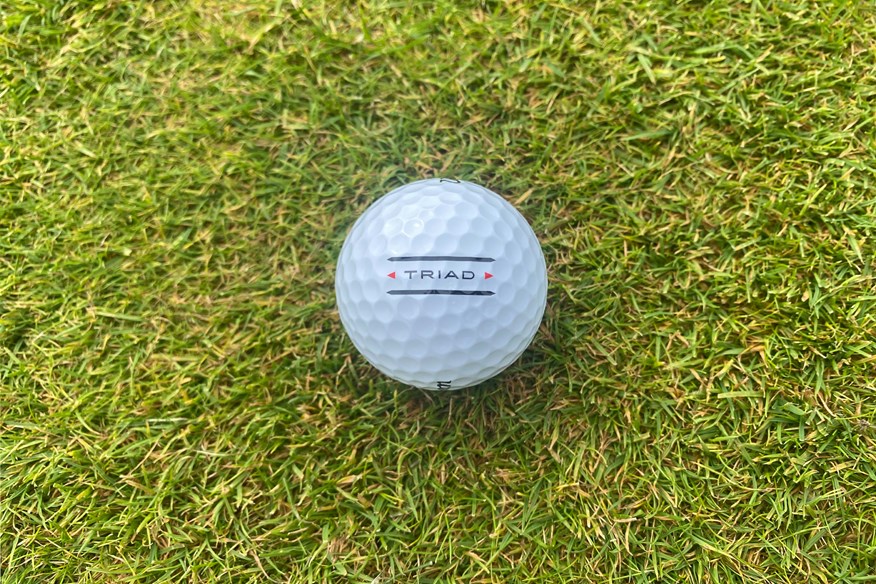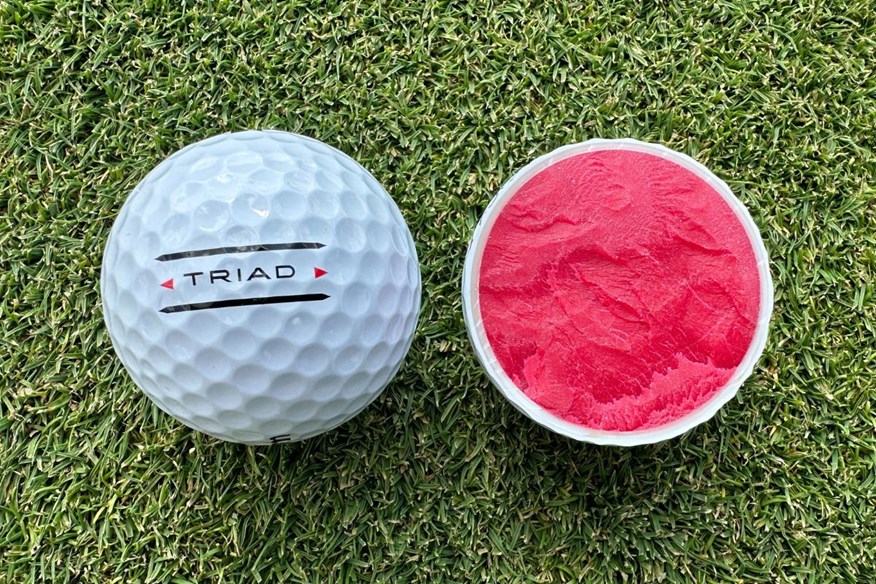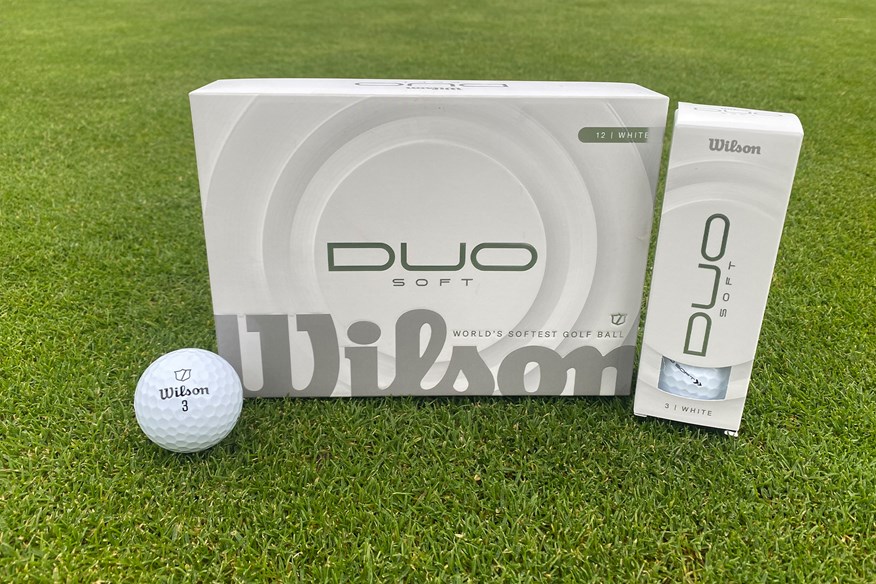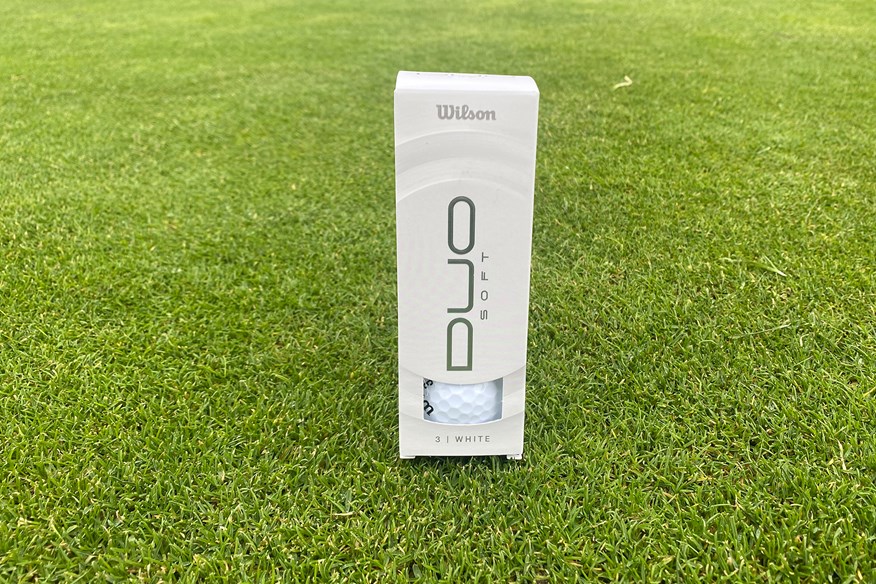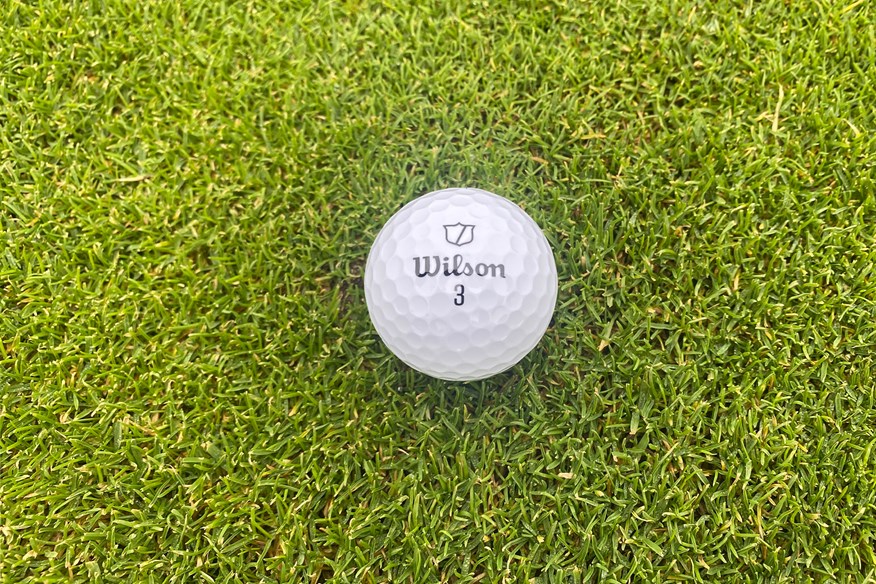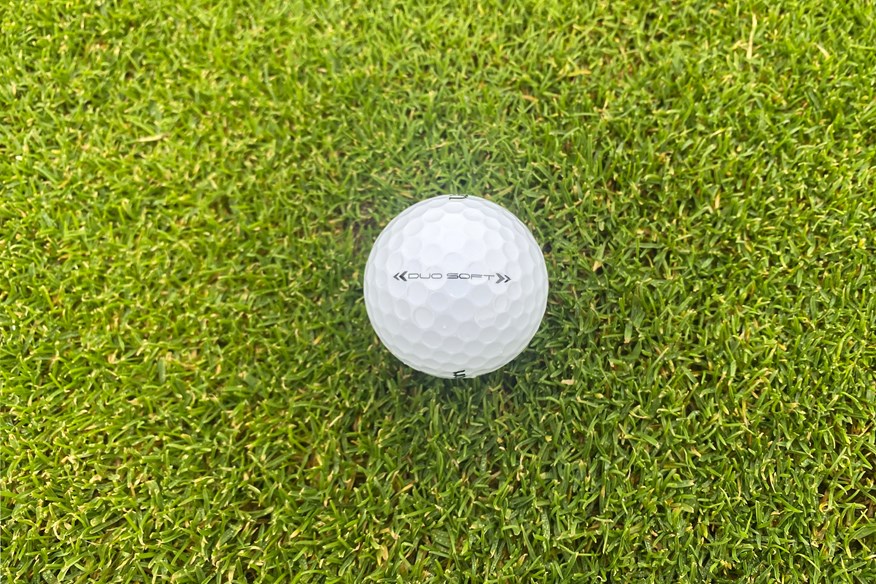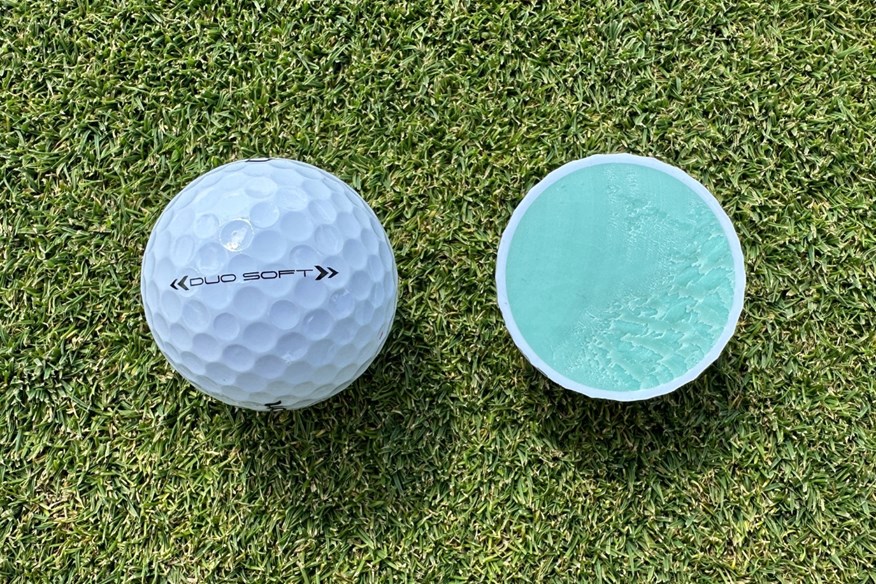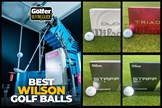Best Wilson golf balls 2025: Tested on an R&D robot and on-course
Last updated:
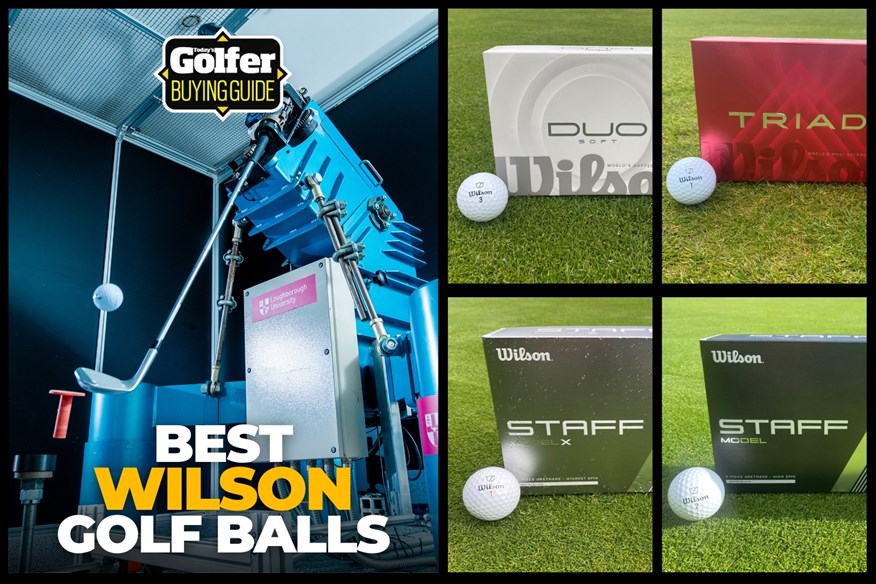
Click here to find out how we conducted our 2025 golf balls test
We’ve tested the most popular and most-played Wilson golf balls on an R&D robot and on-course to help you determine which is the best golf ball for your game.
Jump to:
If you’re interested in playing with the best golf balls, Wilson have to be on your radar. From the best four-piece golf balls to two-piece golf balls, Wilson offers four quality models for every golfer.
To help you in your search for the right golf ball, we carried out our biggest ever golf ball robot test – 62 models from 13 manufacturers. As well as testing on the robot, every golf ball has been tested on-course to provide you with a personal verdict. Click the links below to see how we completed this year’s robot test and to find out exactly how we test golf equipment.
- 2025 golf ball robot test: 62 golf balls, 2,232 shots, 50,000 data points… find out what’s No.1 for you
- How we test golf equipment at Today’s Golfer
Wilson’s premium golf balls – Staff Model and Staff Model X – performed extremely well in our 2025 robot test. Regardless of your ability, every golfer should consider both models. However, if you don’t want to pay the premium price tag, Wilson have two other great models for you to consider.
Best Wilson golf balls 2025: At a glance
One thing you can guarantee from Wilson’s golf balls is that they are expertly designed and manufactured to the highest standard. Whether it’s their golf balls intended for beginners and high-handicappers, or those for Tour players to use.
Despite being one of the most well-known brands in golf, Wilson are often overlooked, and their products are sometimes not as well-received as they should be. I know if anyone asks me for a golf ball recommendation, I’ll be sure to toss a Wilson golf ball into the mix.
Best Wilson golf balls 2025
The most dominant Tour-level golf ball
Best overall Wilson golf ball
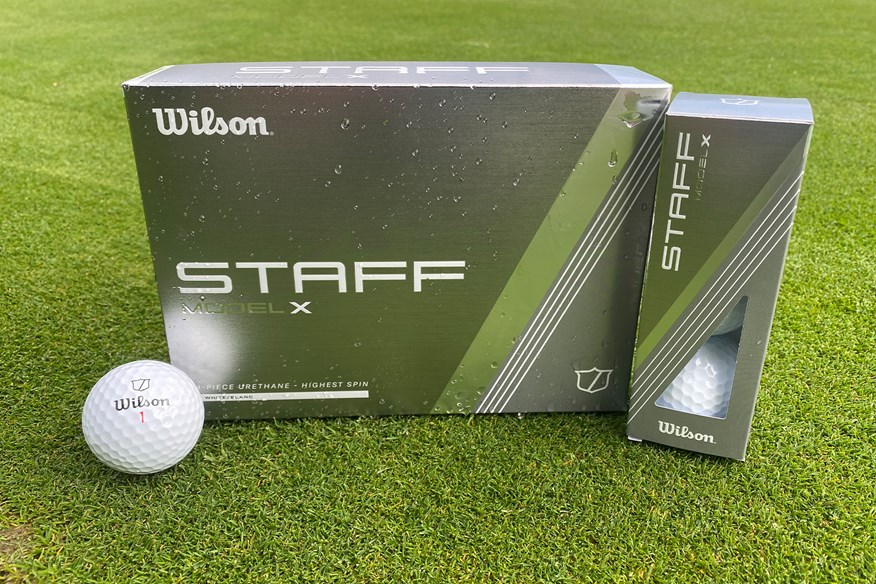

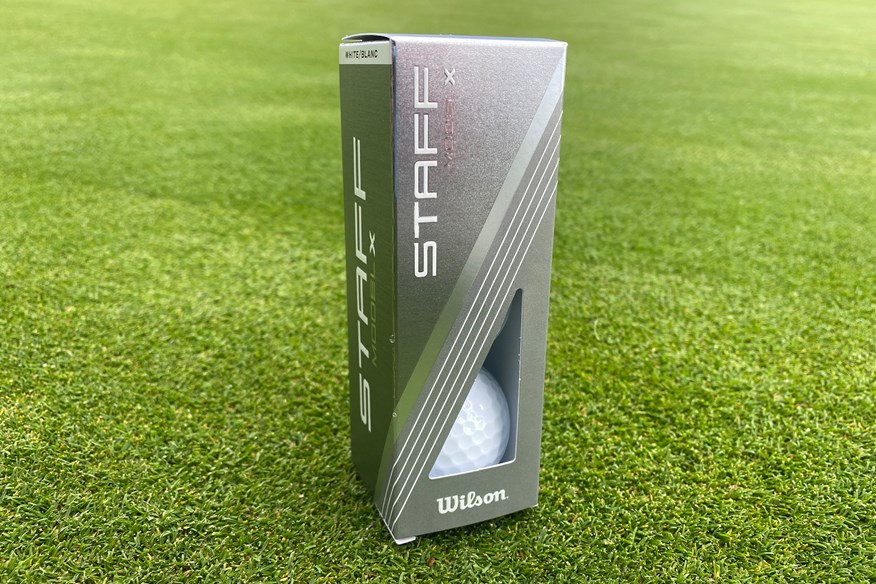
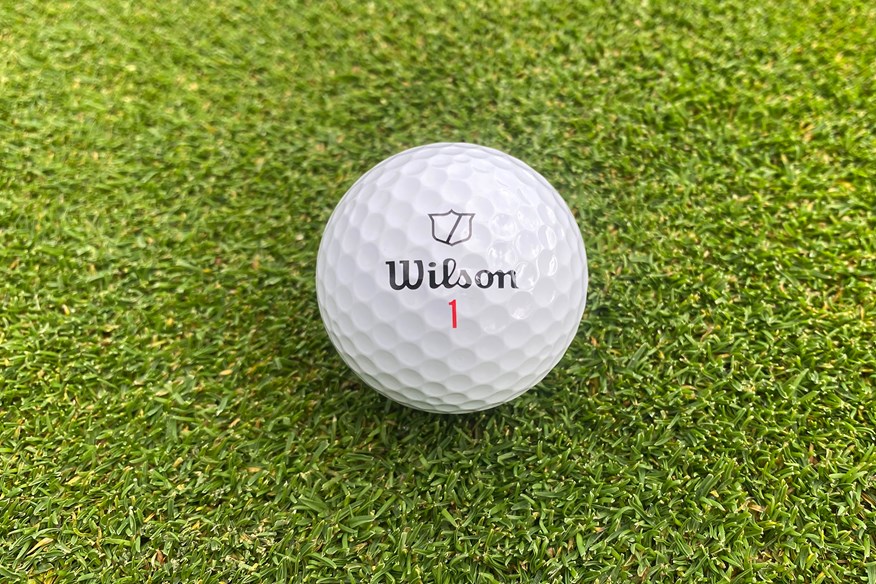
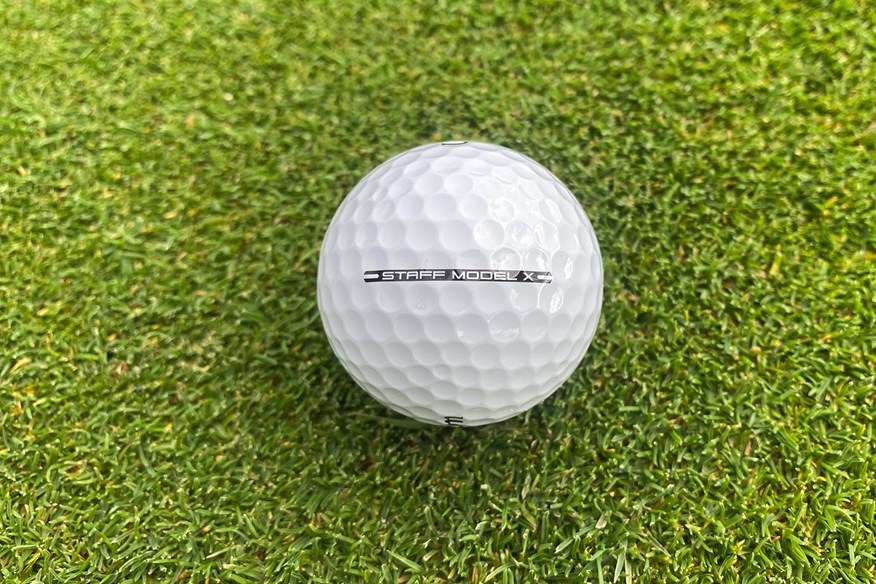

This is arguably the best golf ball in the game. The Wilson Staff Model X is the gold medal winner for tee to green performance at 93mph and 78mph, silver medal winner for tee to green performance at 114mph, silver medal winner for off-the-tee performance, and bronze medal winner for approach play and short game spin.
No other golf ball in our test has received as many awards as the Staff Model X. It's the only golf ball to have received an award in every category.
Staff Model X isn't the longest or fastest golf ball at any of the three driver swing speeds we tested, but it's consistently towards the top of the rankings. It's a higher-spinning golf ball compared to the Staff Model, and that is highlighted with its approach play and short game performance.
This golf ball lands with the steepest descent angle of all 62 tested (45.4°), which helps it easily hit and hold greens. Pair that with the fourth-highest backspin (4,782rpm) and you have a recipe for success.
With the 40-yard pitch shot, Staff Model X generated the third-highest spin (6,091) and again, a steep descent angle (35.5°), meaning this golf ball will stop very quickly when playing around the greens.
On-course verdict
Since being released at the start of 2024, the Staff Model X has been one of my favourite golf balls to play with over the past couple of years. I have a ton of confidence in this model whenever I put it in play. It has become a go-to golf ball for me when I'm not playing my best golf because I know I can trust it to perform well and true.
With its firm feel, it may not appeal to every golfer, but this makes the ball extremely responsive, providing brilliant feedback on all shots. The firm feel is noticeable, compared to softer golf balls, but after a couple of rounds, you practically forget it's a firm golf ball.
Off the tee, the Staff Model X offers slightly more spin than the Staff Model, but that doesn't hinder its overall carry distance. The higher-spinning nature of this model means greenside spin and control is very strong.
The Wilson Staff Model X is the full package. If you're shopping for a premium Tour-level golf ball, this is the No.1 option for golfers of all abilities to consider.
Read our full Wilson Staff Model X golf ball review.
Pros
- Extremely responsive thanks to the firm-feeling
- Performs highly for golfers of all abilities
- Amazing short-game spin and control
Cons
- Higher-spinning than the Staff Model off the tee
| Carry distance (yds) | Driver 114mph - 273.7 | Driver 93mph - 209.8 | Driver 78mph - 162.2 | 7-iron - 156.1 |
| Ball speed (mph) | Driver 114mph - 164.3 | Driver 93mph - 134.6 | Driver 78mph - 113.4 | 7-iron - 109.3 |
| Backspin (rpm) | Driver 114mph - 2,797 | Driver 93mph - 2,792 | Driver 78mph - 2,623 | 7-iron - 4,782 | Pitch - 6,091 |
| Launch angle (°) | Driver 114mph - 11.2 | Driver 93mph - 12.5 | Driver 78mph - 13.8 | 7-iron - 21 | Pitch - 30.4 |
| Descent angle (°) | Driver 114mph - 38.4 | Driver 93mph - 32.6 | Driver 78mph - 28.1 | 7-iron - 45.4 | Pitch - 35.5 |
| Peak height (yds) | Driver 114mph - 33.7 | Driver 93mph - 22.6 | Driver 78mph - 15.9 | 7-iron - 30 | Pitch - 6.7 |
| Compression (psi) | 114 |
- V-Cor advanced performance
- Firm compression core with velocity-boosting additive
- 3SIX2 seamless urethane cover
- 362 dimples
- 4-Piece construction
- Available in white and yellow
Gold medal for tee to green performance at 114mph
The Wilson Staff Model is a very impressive golf ball that unfortunately sits in the shadow of the Staff Model X. That might sound harsh, considering this is the best golf ball for tee to green performance at 114mph in this category.
At the 114mph driver swing speed, this is the third-longest golf ball, and one of only three to exceed 274 yards in the entire test. At a moderate and slower swing speed, the Staff Model is a solid performer, but not as strong as the Staff Model X - third at 93mph and second at 78mph.
There is one area where the Staff Model outshines the Staff Model X, and that's with approach play. Staff Model scooped up the silver medal for approach play with the Staff Model X, one place behind in the bronze medal position.
Approaching and playing around the greens, the Staff Model doesn't generate as much spin as the Staff Model X, but its distance is more consistent. Despite being a lower-spinning golf ball, you might be able to trust the Staff Model more to carry a repeatable distance - even if it is shorter.
At quick swing speeds, this is definitely a good option if you want a golf ball that can do everything, but with the Staff Model X just behind at 114mph for tee to green performance, and given how it's better-performing almost everywhere else, it's hard not to recommend the Staff Model X instead.
That being said, the best way to differentiate is if you want a lower-spinning, softer golf ball, go for the Staff Model.
On-course verdict
The Staff Model is a very strong performer from tee to green. If you don't want a high-spinning, firm-feeling golf ball, this is your best option. This model isn't as impressive as the Staff Model X, but it's pretty darn close.
From tee to green, the Staff Model is super consistent, and it ticks a lot of boxes for the majority of golfers. Regardless of your ability or swing speed, the Staff Model will work for you if you want a golf ball that's easy to control when playing into and around greens and competitive for distance off the tee.
There's a ton to like about the Staff Model, and its softer feel compared to the Staff Model X is sure to please a lot of golfers.
Read our full Wilson Staff Model golf ball review.
Pros
- Incredible distance off the tee
- Amazing short game performance
- Softer feel will be appreciated by many golfers
Cons
- Overall performance is just below that of the Staff Model X
| Carry distance (yds) | Driver 114mph - 274.3 | Driver 93mph - 209.2 | Driver 78mph - 161.7 | 7-iron - 156.3 |
| Ball speed (mph) | Driver 114mph - 164.7 | Driver 93mph - 134 | Driver 78mph - 113.3 | 7-iron - 109 |
| Backspin (rpm) | Driver 114mph - 2,829 | Driver 93mph - 2,703 | Driver 78mph - 2,595 | 7-iron - 4,653 | Pitch - 5,993 |
| Launch angle (°) | Driver 114mph - 11.2 | Driver 93mph - 12.8 | Driver 78mph - 13.9 | 7-iron - 21.1 | Pitch - 30.6 |
| Descent angle (°) | Driver 114mph - 38.6 | Driver 93mph - 32.4 | Driver 78mph - 28 | 7-iron - 45.2 | Pitch - 35.8 |
| Peak height (yds) | Driver 114mph - 34.1 | Driver 93mph - 22.5 | Driver 78mph - 15.8 | 7-iron - 29.8 | Pitch - 6.8 |
| Compression (psi) | 112 |
- V-Cor advanced performance
- Medium compression core with velocity-boosting additive
- 3SIX2 seamless urethane cover
- 362 dimples
- 4-Piece construction
- Available in white and yellow
Silver medal for approach play performance
We're huge fans of the Wilson Triad at Today's Golfer because it's such a consistent golf ball that you can trust.
The one area where you can really depend on the Triad to perform is when you're approaching greens. This golf ball is the second-best golf ball for approach play performance among the 3-piece club golfer models.
The Triad isn't particularly long (156.4yds) or high-spinning (4,474rpm), but its carry distance consistency is right up there with the best in the entire test, ranking seventh overall.
You're not getting a high-spin golf ball for around the greens with the Triad. This golf ball is below the test average with 5,554rpm.
Off the tee, the Triad is a very average performer at all three swing speeds. Spin does creep up across the board, and that does hurt the Triad for distance.
Overall, the Triad is a low-spinning golf ball. It's not as low-spinning as the Duo Soft, but based on its overall performance, it cements itself as one of the best low-spin golf balls, generating 17,545rpm across all three driver swing speeds, the 7-iron shot, and the 40-yard pitch.
The Triad is also considered to be a low-spin golf ball compared to the high-spinning Staff Model and Staff Model X. If you want to play with a Wilson golf ball that's going to deliver great performance and low spin, look no further than this model.
That being said, the Triad is designed to help golfers break 80, and if you're looking to achieve that, this golf ball is a great companion.
On-course verdict
The Triad isn’t the sexiest of golf balls – no one is turning their head when you announce you’re playing one – but I quite like that. It’s a very practical golf ball, built to help you shoot lower scores.
I don’t think golf balls get more versatile than the Wilson Triad – it epitomises versatility. I honestly think a scratch golfer or complete newbie could switch to this golf ball and find enjoyment. Triad works for anyone and everyone.
The soft feel doesn’t reduce the responsiveness of the Triad. I find this golf ball to be highly responsive. I think with it having a thin cover, you can really feel the golf ball making contact with the face. I find the feedback gets stronger as you move down your bag. So, the response with a wedge is stronger than the response when you hit driver.
Read our full Wilson Triad golf ball review.
Pros
- Extremely consistent golf ball
- Amazing approach play performance
- Very easy to trust
Cons
- Doesn't blow you away in any area
| Carry distance (yds) | Driver 114mph - 268.2 | Driver 93mph - 205.6 | Driver 78mph - 159.7 | 7-iron - 156.4 |
| Ball speed (mph) | Driver 114mph - 161.7 | Driver 93mph - 132.6 | Driver 78mph - 112.8 | 7-iron - 108.5 |
| Backspin (rpm) | Driver 114mph - 2,734 | Driver 93mph - 2,707 | Driver 78mph - 2,456 | 7-iron - 4,474 | Pitch - 5,554 |
| Launch angle (°) | Driver 114mph - 11.2 | Driver 93mph - 12.7 | Driver 78mph - 13.9 | 7-iron - 21.1 | Pitch - 31.2 |
| Descent angle (°) | Driver 114mph - 37.1 | Driver 93mph - 31.9 | Driver 78mph - 27.6 | 7-iron - 44.7 | Pitch - 36.9 |
| Peak height (yds) | Driver 114mph - 31.7 | Driver 93mph - 21.8 | Driver 78mph - 15.5 | 7-iron - 29.3 | Pitch - 7.2 |
| Compression (psi) | 89 |
- Tri-balanced construction
- High MOI
- Thin, high-friction urethane cover
- 362 dimples
- 3-Piece construction
- Available in white and yellow
Wilson's most surprising golf ball
The Duo Soft is Wilson's most surprising model, but, sadly, not for the right reasons.
Out of all 62 golf balls, the Duo Soft is one of the lowest-performing models. Factoring in off-the-tee, tee to green, approach play, and short game performance, this golf ball finished 59th overall.
The Duo Soft performs best (if you can call it that) in short game performance. With 5,442rpm, this model is the 53rd highest-spinning golf ball (15th in this category).
There are fans of the Duo Soft, and we expected this ball to perform better, but, based on our findings, there are much better golf balls to choose from.
On-course verdict
Where the Duo Soft impressed me most was with scoring clubs (clubs I play with when I have 100 – 160 yards in). This typically includes my 54° wedge to 8-iron – depending on the wind. The spin exhibited when I was playing with these clubs was very good and the ball was very accurate. What I learned is, full shots with lofted clubs are the Duo Soft’s bread and butter.
You can’t argue that the Duo Soft isn’t a long golf ball, it’s basically a soft-feeling distance golf ball at this point, but it’s not freakishly long, and with the low compression, I don’t get as much from this ball as other golfers with slower swing speeds would. It still travels a good distance, but I’d rather play a premium golf ball to help me optimise distance off the tee.
Read our full Wilson Duo Soft golf ball review.
Pros
- Impressive spin and control with scoring clubs
- Highly durable - even in the matte finish
- Very good price
Cons
- Difficult to optimise performance if you have a quick swing speed
| Carry distance (yds) | Driver 114mph - 263.7 | Driver 93mph - 203.8 | Driver 78mph - 158.4 | 7-iron - 158.3 |
| Ball speed (mph) | Driver 114mph - 159.2 | Driver 93mph - 131.8 | Driver 78mph - 112 | 7-iron - 108.1 |
| Backspin (rpm) | Driver 114mph - 2,689 | Driver 93mph - 2,540 | Driver 78mph - 2,220 | 7-iron - 4,019 | Pitch - 5,442 |
| Launch angle (°) | Driver 114mph - 11.5 | Driver 93mph - 12.9 | Driver 78mph - 14.3 | 7-iron - 21.8 | Pitch - 31.9 |
| Descent angle (°) | Driver 114mph - 36.7 | Driver 93mph - 30.9 | Driver 78mph - 26.5 | 7-iron - 44.3 | Pitch - 37.8 |
| Peak height (yds) | Driver 114mph - 31 | Driver 93mph - 21.1 | Driver 78mph - 15 | 7-iron - 29.4 | Pitch - 7.6 |
| Compression (psi) | 55 |
- High-energy core
- Straighter flight
- 302 dimples
- 2-Piece construction
- Available in white, green, pink, red, and yellow
- An alternative model is the TRK360
Best Wilson golf Balls: Robot test data
| Golf ball | Wilson Staff Model X | Wilson Staff Model | Wilson Triad | Wilson Duo Soft |
| Compression | 114 | 112.0 | 89.0 | 55 |
| 114mph Driver Ball Speed (mph) | 164.3 | 164.7 | 161.7 | 159.2 |
| 114mph Driver Launch Angle (°) | 11.2 | 11.2 | 11.2 | 11.5 |
| 114mph Driver Backspin (rpm) | 2797 | 2829 | 2734 | 2689 |
| 114mph Driver Carry Distance (yds) | 273.7 | 274.3 | 268.2 | 263.7 |
| 114mph Driver Height (yds) | 33.7 | 34.1 | 31.7 | 31.0 |
| 114mph Driver Descent Angle (°) | 38.4 | 38.6 | 37.1 | 36.7 |
| 93mph Driver Ball Speed (mph) | 134.6 | 134.0 | 132.6 | 131.8 |
| 93mph Driver Launch Angle (°) | 12.5 | 12.8 | 12.7 | 12.9 |
| 93mph Driver Backspin (rpm) | 2792 | 2703 | 2707 | 2540 |
| 93mph Driver Carry Distance (yds) | 209.8 | 209.2 | 205.6 | 203.8 |
| 93mph Driver Height (yds) | 22.6 | 22.5 | 21.8 | 21.1 |
| 93mph Driver Descent Angle (°) | 32.6 | 32.4 | 31.9 | 30.9 |
| 78mph Driver Ball Speed (mph) | 113.4 | 113.3 | 112.5 | 112.0 |
| 78mph Driver Launch Angle (°) | 13.8 | 13.9 | 13.9 | 14.3 |
| 78mph Driver Backspin (rpm) | 2623 | 2595 | 2546 | 2220 |
| 78mph Driver Carry Distance (yds) | 162.2 | 161.7 | 159.7 | 158.4 |
| 78mph Driver Height (yds) | 15.9 | 15.8 | 15.5 | 15.0 |
| 78mph Driver Descent Angle (°) | 28.1 | 28.0 | 27.6 | 26.5 |
| 7-Iron Ball Speed (mph) | 109.3 | 109.0 | 108.5 | 108.1 |
| 7-Iron Launch Angle (°) | 21.0 | 21.1 | 21.1 | 21.8 |
| 7-Iron Backspin (rpm) | 4782 | 4653 | 4474 | 4019 |
| 7-Iron Carry Distance (yds) | 156.1 | 156.3 | 156.4 | 158.3 |
| 7-Iron Height (yds) | 30.0 | 29.8 | 29.3 | 29.4 |
| 7-Iron Descent Angle (°) | 45.4 | 45.2 | 44.7 | 44.3 |
| 40-Yard Pitch Ball Speed (mph) | 46.3 | 46.4 | 46.6 | 47.0 |
| 40-Yard Pitch Launch Angle (°) | 30.4 | 30.6 | 31.2 | 31.9 |
| 40-Yard Pitch Backspin (rpm) | 6091 | 5993 | 5554 | 5442 |
| 40-Yard Pitch Carry Distance (yds) | 39.6 | 39.8 | 40.5 | 41.4 |
| 40-Yard Pitch Height (yds) | 6.7 | 6.8 | 7.2 | 7.6 |
| 40-Yard Pitch Descent Angle (°) | 35.5 | 35.8 | 36.9 | 37.8 |
Best Wilson golf balls 2025: Buying guide
Wilson have a smaller selection to choose from compared to other brands, so figuring out which Wilson golf balls to play with is potentially easier than with any other brand. Despite only having a select range of golf balls, there is an option for everyone, and Wilson can be your ball manufacturer of choice throughout your golfing journey.
While the choice might seem straightforward because of there being so few choices, there are still a few factors to take into consideration to pick the best option for your game.
Ability
Regardless of your ability, you will benefit from playing with the Wilson Staff Model or Staff Model X. Both of Wilson’s premium golf balls finished within the top three of our 2025 robot test, with the Staff Model X emerging as the best golf ball of 2025.
Better and more seasoned golfers arguably should be playing with the best balls they can afford to be playing with because it will 100 per cent improve your game from tee to green. The flip side to that is, if you’re new to the game or play infrequently with your buddies, work colleagues, or whoever, then you might not have the game to warrant playing with premium golf balls for whatever reason. At that point, playing with cheap golf balls is perfectly understandable.
That being said, switching to one of the best value golf balls could help you play better golf and find more enjoyment – even if you do just play for fun.
Budget
Tied closely with ability is budget. Thankfully, Wilson golf balls are very reasonably priced. Both Staff Model golf balls are among the more affordable premium golf balls.
Players who are new to the game or don’t get out often are more likely to budget when it comes to purchasing golf balls. Whereas more frequent and skilled golfers are less likely to budget and opt for more expensive golf balls. That’s not to say every golfer meeting one of those credentials behaves this way.
While I’ve probably been alive less number of years than some of you have played golf, I’ve had the pleasure of working in the golf industry for the entirety of my working life. During that time, I’ve seen golfers of all abilities splashing the cash on the latest golf clubs in the hope of improving their game and being thrifty when it comes to spending on golf balls – I’ve been a culprit of this myself in my early golfing days!
If there’s ever a piece of golf equipment you shouldn’t be frugal with, it’s golf balls!
Feel
The vast majority of golfers look for soft-feeling golf balls. The only firm golf ball Wilson offers is the Staff Model X. I wouldn’t necessarily class it as a firm golf ball, but it’s definitely firmer than the other three Wilson golf balls. The Staff Model X is my favorite feeling golf ball, but I’m well aware that might not be the case for most golfers. Many golfers enjoy soft-feeling golf balls because they deliver a sweet sensation off of every club in the bag – except if you skull one.
I enjoy playing with firmer golf balls because I feel as though they provide more feedback and a stronger response. However, feel is completely personal, and like I say, it’s tough to find a super-firm golf ball because most are made to be soft to please the needs of more golfers.
Performance
Every Wilson golf ball comes fitted with specific technology to perform in a particular manner – this is often outlined on the box. For instance, it might inform you that a certain model is designed to travel high and far off the tee with low spin but grab and spin on the greens. Another golf ball might say it produces low flight off the tee and mid-spin in the short game.
Although Wilson have a smaller range of golf balls than other brands, they offer golf balls for every golfer’s needs; whether you’re looking for a high-spinning, high-launching, soft, firm, or fast golf ball, Wilson has you covered.
To save you from working out which model you think is right for you. We have the answer. We’ve carried out a mammoth robot test to help you see how well a ball stacks up to the claims made by the manufacturer.
Spin
Ideally, every golf ball would produce low-spin off the tee and high-spin in your approach game. However, not all golf balls are designed that way. The majority of golf balls are designed to produce low driver spin and generate distance off the tee, but not all golf balls are manufactured to generate high spin from irons and wedges.
Price generally correlates with short-game spin. Budget golf balls will generate less short-game spin than expensive golf balls, but there might not be much difference in your long-game spin. During a ball fitting at Titleist, I discovered that a Titleist Pro V1x and Titleist Velocity performed very similarly with my driver, but with a 7-iron, the spin dropped slightly with the Velocity, and then with a 60° wedge, the spin fell massively with the Velocity.
Spin in the golf ball comes from the combination of layers within the golf ball reacting with one another, hence why more expensive golf balls spin more in approach play because they consist of more layers and the technology is more refined. Cheaper golf balls tend to consist of two layers: the cover and core. Therefore, they don’t have the number of layers required to produce astronomical spin when attacking pins.
Another factor that helps to enhance spin is the cover material. Golf balls with a urethane cover tend to spin more (but not always) because it’s a more flexible material compared to ionomer or surlyn, which doesn’t create as much friction with the clubface as urethane does. Once again, it’s more expensive golf balls that feature urethane covers to generate higher spin on approach shots.
Spin is massively important because it can either make you hit and hold a green or hit and fly over the green. The best golf balls for spin are by far premium golf balls, closely followed by golf balls for mid-handicappers, because they feature much of the technology found in Tour-standard golf balls. If you feel as though you need high levels of spin when attacking greens, have a look at the best high-spin golf balls. Alternatively, if you feel as though spin is hurting your game, check out the best low-spin golf balls.
Distance
I would honestly say that distance is the last factor to consider when purchasing golf balls. The best way to figure out which golf balls are best for you is by working your way back from the green to the tee box. The best way of doing this is with a launch monitor to see your numbers, but if you don’t have access to one, you can do it with your eye very easily.
Start by hitting wedge shots into the green and see which balls are performing best with spin, then work your way back to 7-iron distance and look for the same numbers with slightly more of an eye on carry distance. You should have whittled it down to one or two golf balls, hit them off the tee, and look at which performs the best.
If you do it this way, I guarantee a premium golf ball will always come out on top if you’re testing one. However, if you’re doing this with cheaper golf balls, you’ll still see differences between the golf balls, and you will find one that performs well for you, or you might have the luxury of deciding between a handful.
By testing golf balls this way, you’ll end up with the ball that performs best in the short game, which is where you score. Distance is important, but there are other ways of improving distance without sacrificing spin in a golf ball.
Colour
The most common golf ball colour is white; however, there are plenty of other colours and designs to choose from. More vibrant colours, such as yellow, orange, or green, are all easy to pick up, and they help some people with visibility – hence why they make for the best winter golf balls.
Other ways of adding colour to the golf ball can be by design, whether it be a splash of colour seen on Vice golf balls or an alignment design which also helps with visibility, such as TaylorMade’s Pix golf balls or Callaway’s Triple Track golf balls.
If you’ve only ever played with white golf balls, it might be worth trying a more colourful golf ball, especially if you’re always the one asking your playing partners, “Where did that one go?”.
Alignment
More and more golf balls are being released with enhanced alignment, and even standard golf balls have a more prominent alignment stamp now than they’ve ever had. The majority of brands now offer golf balls with enhanced alignment aids. The enhanced alignment aids can be extremely useful for putting and even lining up shots on the tee. Another plus of alignment golf balls is the alignment serves as a tool for finding your golf ball either in the air or among the trees.
Best Wilson golf balls 2025: FAQs
What to read next
For performance insights tailored to your swing speed and preferences, head to our results hubs:
- Best 4 and 5-piece golf balls
- Best 3-piece golf balls
- Best 2-piece golf balls
- Best golf balls for fast swing speeds
- Best golf balls for average swing speeds
- Best golf balls for slow swing speeds
- Best golf balls for distance
- Best golf balls for approach play
- Best golf balls for mid-handicaps
- Best golf balls for beginners
- Most consistent golf balls
